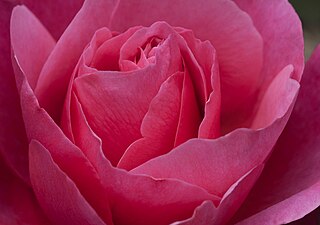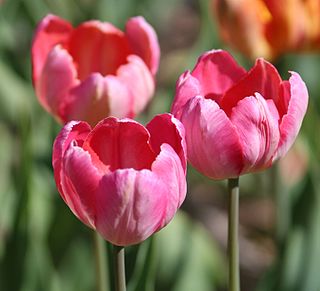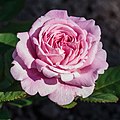
Indigo is a deep color close to the color wheel blue, as well as to some variants of ultramarine, based on the ancient dye of the same name. The word "indigo" comes from the Latin word indicum, meaning "Indian", as the plant-based dye was originally exported to Europe from India.

A rose is either a woody perennial flowering plant of the genus Rosa, in the family Rosaceae, or the flower it bears. There are over three hundred species and tens of thousands of cultivars. They form a group of plants that can be erect shrubs, climbing, or trailing, with stems that are often armed with sharp prickles. Their flowers vary in size and shape and are usually large and showy, in colours ranging from white through yellows and reds. Most species are native to Asia, with smaller numbers native to Europe, North America, and northwestern Africa. Species, cultivars and hybrids are all widely grown for their beauty and often are fragrant. Roses have acquired cultural significance in many societies. Rose plants range in size from compact, miniature roses, to climbers that can reach seven meters in height. Different species hybridize easily, and this has been used in the development of the wide range of garden roses.

Dianthus caryophyllus, commonly known as carnation or clove pink, is a species of Dianthus native to the Mediterranean region. Its exact natural range is uncertain due to extensive cultivation over the last 2,000 years. Carnations are prized for their vibrant colors, delicate fringed petals, and enchanting fragrance.

Rosa rugosa is a species of rose native to eastern Asia, in northeastern China, Japan, Korea and southeastern Siberia, where it grows on beach coasts, often on sand dunes. It should not be confused with Rosa multiflora, which is also known as "Japanese rose". The Latin word "rugosa" means "wrinkled", referring to the wrinkled leaves. Often used as an ornamental plant, it has become invasive in parts of Europe, North America and South America.

Hibiscus syriacus is a species of flowering plant in the mallow family, Malvaceae. It is native to south-central and southeast China, but widely introduced elsewhere, including much of Asia, both in the east and the west. It was given the epithet syriacus because it had been collected from gardens in Syria. Common names include the rose of Sharon,, Syrian ketmia, shrub althea, and rose mallow. It is the national flower of South Korea and is mentioned in the South Korean national anthem.

Hibiscus rosa-sinensis, known colloquially as Chinese hibiscus, China rose, Hawaiian hibiscus, rose mallow and shoeblack plant, is a species of tropical hibiscus, a flowering plant in the Hibisceae tribe of the family Malvaceae. It is widely cultivated as an ornamental plant in the tropics and subtropics, but its native range is Vanuatu.

Rosa 'Anne Harkness' is an apricot floribunda rose cultivar developed by Jack Harkness in 1979 and introduced into Great Britain in 1980. The rose makes an outstanding cut flower and is exceptionally long lasting in water.

Artificial plants are imitations of natural plants used for commercial or residential decoration. They are sometimes made for scientific purposes. Artificial plants vary widely from mass-produced varieties that are distinguishable from real plants by casual observation to highly detailed botanical or artistic specimens.

Tagetes erecta, the Aztec marigold, Mexican marigold, big marigold, cempaxochitl or cempasúchil, is a species of flowering plant in the genus Tagetes native to Mexico, Guatemala and Peru. Despite being native to the Americas, it is often called the African marigold. In Mexico, this plant is found in the wild in the states of México, Michoacán, Puebla, Veracruz and Guerrero.

The Peace rose, formally Rosa 'Madame A. Meilland', is a well-known and successful garden rose. By 1992, over one hundred million plants of this hybrid tea had been sold. The cultivar has large flowers of a light yellow to cream color, slightly flushed at the petal edges with crimson-pink. It is hardy and vigorous and relatively resistant to disease, making it popular in gardens as well as in the floral trade.

Rosa'Double Delight',, is a multiple award-winning, red blend hybrid tea rose cultivar bred in the United States by Swim & Ellis and introduced in 1977. Its parents were two hybrid tea cultivars, the red and yellow 'Granada' and the ivory 'Garden Party'.

Tuberous begonias are a group of Begonia cultivars, sometimes regarded as some of the most spectacular of the genus.

Flower preservation has existed since early history, although deliberate flower preservation is a more recent phenomenon. In the Middle East, the bones of pre-historic man were discovered with delicate wild flowers probably as a tribute to a passing loved one. Evidence of deliberate use of specific flowers is indicated by the pollen grains that were present. Brightly colored and vivid flowers were also found in Egyptian tombs. These flowers were approximated to be 4,000 years old. In the sixteenth century medicinal nosegays began to give way to ornamental ones. Flowers essentially started to be used for decorative purposes such as jewels, fans and gloves. During the Elizabethan Age the once familiar ruff was replaced by soft lacy collars, and bosom flowers also became popular.

Rosa 'Line Renaud' is a hybrid tea rose cultivar bred in France by Meilland International SA and introduced in 2006. It was named for French actress Line Renaud.

Blue flower colour was always associated with something unusual and desired. Blue roses especially were assumed to be a dream that cannot be realised. Blue colour in flower petals is caused by anthocyanins, which are members of flavonoid class metabolites. We can diversify three main classes of anthocyanin pigments: cyaniding type responsible for red coloration, pelargonidin type responsible for orange colour and delphinidin type responsible for violet/blue flower and fruits coloration. The main difference in the structure of listed anthocyanins type is the number of hydroxyl groups in the B-ring of the anthocyanin. Nevertheless, in the monomeric state anthocyanins never show blue colour in the weak acidic and neutral pH. The mechanism of blue colour formation are very complicated in most cases, presence of delphinidin type pigments is not sufficient, great role play also the pH and the formation of complexes of anthocyanins with flavones and metal ions.

Rosa 'Voodoo',, is a hybrid tea rose cultivar, bred by Jack Christensen in 1984. The rose variety was created from the stock parents: grandiflora 'Camelot'; hybrid tea, 'First Prize'; hybrid tea, 'Typhoo Tea'; and hybrid tea, 'Lolita'. The cultivar was named an All-America Rose Selections winner in 1986.

Rosa 'Queen Elizabeth' is a pink Grandiflora rose cultivar, bred by rose grower, Dr. Walter Lammerts in the United States in 1954. The rose variety is very popular worldwide and has won numerous awards, including "World's Favorite Rose", (1979).

Rosa 'Spek's Centennial',, is a floribunda rose cultivar, bred by Sam McGredy IV. It was introduced into New Zealand by Egmont Roses in 1991. The rose cultivar was later introduced into the United States by Edmunds' Roses in 1994 as 'Singin' in the Rain'. The rose was named an All-America Rose Selections winner in 1995.

Rosa 'Soleil d'Or' is a Foetida hybrid rose cultivar, bred by Joseph Pernet-Ducher and introduced on November 1, 1900. It is the ancestor of all modern Hybrid tea roses and the first yellow-orange rose. Pernet-Ducher later crossed 'Soleil d'Or' with Tea roses to create a new class known as Pernetiana roses.

Parrot tulips are a tulip cultivar group known for their bright colors and petals. The petals have a "serrated" or "fringed" look. The flowers bloom in late spring and reach a size of almost 5 inches (13 cm) in length. Although they are perennials by nature٫ they are often grown as annuals. Parrot tulips come in a wide variety of colors, usually being brightly colored, but can come in darker colors. The flowers originated in France and were brought to the Netherlands in the 18th century.























